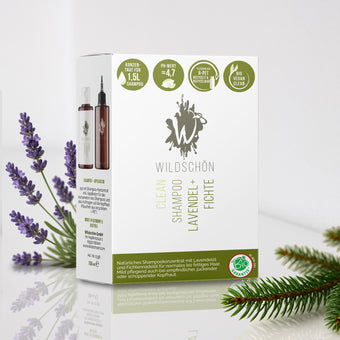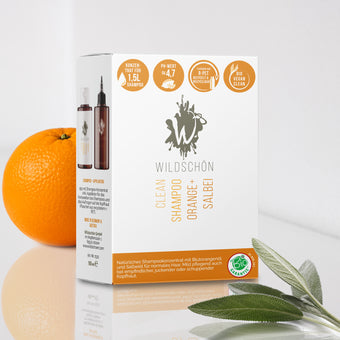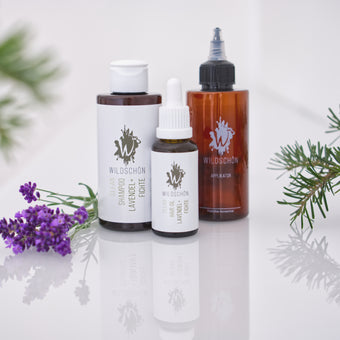Biodegradable - what does that actually mean for cosmetic and hair care products?
- How to recognize products that are good for you and the environment.
- Do the manufacturers hide harmful ingredients in the ingredient lists?
- What can you do for more sustainability in hair care?
Out of sight - out of mind. Unfortunately, this is often the case with cosmetics and hair care products. We use them and enjoy their effects: Everyone likes beautiful hair or supple skin. But what effect do these products have once they have disappeared down the drain? A lot of people don't give that much thought. The concrete effects on complex ecosystems are too different and diverse for us to be able to examine them comprehensively in this article. But what you have probably already noticed: It makes sense if as few ingredients as possible are released into nature that are potentially harmful to the environment. Ideally, they are “biodegradable”. But what does that mean for cosmetic products? And why is that even important? We explore these and other questions in this article.
Let's start with the term itself: biodegradability - what is that exactly?
With regard to industrially manufactured substances, biodegradability is always about the following question: "Is it ideally possible for a substance to be broken down by microorganisms (mainly bacteria) into elementary components such as carbon, oxygen, etc.?". However, decomposition is basically a natural process that does not only affect artificially produced substances. This also happens in our forests, for example, where leaves, branches and needles would otherwise pile up into mountains. So most of the work is done by microorganisms, both in the wild and in industrial devices. So they are the inhabitants of our bodies of water and soil as well as those of our sewage treatment plants.
Different levels of biodegradability
Since we are looking at biodegradability in relation to cosmetics, the distinction here is broader than just degradable and non-degradable. Because in conventional cosmetic products there are usually many industrially manufactured ingredients, e.g. B. silicones or synthetic surfactants , which may be degradable, but do not take a long time. It is therefore important to further subdivide biodegradability. Doesn't help much if substances only degrade over months or years. Biodegradability is divided into easy, potential/inherent, difficult and non-degradable. In order to determine which category a substance belongs to, there are corresponding measurement methods and limit values that must be achieved.
Measurement of ready degradability
The easy biodegradability is the best level, so to speak. A substance is readily biodegradable if it can be quickly and completely decomposed by microorganisms in an appropriate environment. In the case of easy biodegradability, the whole thing already happens in the sewage treatment plant. So let's be quick, because the water is out there after about 2 days (sometimes even faster). If a substance is not easily biodegradable, then this must be examined more closely. This can happen in the lab. There, it is examined whether a substance can be decomposed within four weeks in a sludge animated by microorganisms. If this is the case, one speaks of potential or inherent biodegradability. Another test method for substances that are not easily biodegradable is the simulation test. It examines whether the substance could be degraded if it went through the normal sewage treatment plant process. So that as little damage as possible is caused to the environment during this investigation, the whole thing takes place in a "model sewage treatment plant". Hence the name simulation test.
Why should cosmetic ingredients be biodegradable?
There are actually two categories of biodegradability left that we haven't talked about yet. But if you think back to how quickly the wastewater goes through the sewage treatment plants, you will realize that only the easy biodegradability counts. Because all substances that are not easily biodegradable continue to swim in our environment. A prominent example here is the topic of “microplastics”. These smallest plastic particles are difficult to biodegrade. Accordingly, they appear not only on the sea surface, but also in the deep sea, in the Arctic and even in the snow of the Alps. Since fish and other edible sea creatures are known to live in water, microplastics can also end up on your plate. With more than 33,000 substances on the INCI list (International Nomenclature of Cosmetic Ingredients), there are even more “problem children” than just microplastics. And with an estimated annual consumption of 450,000 tons of cosmetics (in Germany alone!), quite a bit floats away with the water when we use cosmetic products. So the microorganisms in the sewage treatment plants have a lot to do.
Are natural ingredients more easily biodegradable than synthetically produced ones?
In principle, one could assume that natural (ingredients) are easier to break down than synthetically produced ones. Often one thinks of the good old compost heap in the garden corner, which becomes nutrient-rich humus. Ultimately, however, the origin of a substance is not decisive for its biodegradability. Rather, it is its chemical structure. This means that there are also natural substances that are not easily biodegradable due to their chemical structure. This is often the case when they have been chemically modified. These structural changes are carried out in order to achieve certain effects or to achieve tolerance requirements. These are still natural substances, but since their chemical structure has been slightly modified, this can also change their biodegradability.
What about conventional cosmetic products that advertise ingredients of natural origin?
"Organic", "natural" or "free from ..." not only sounds good, but is also important for more and more people. After all, we want our beautiful planet to be preserved for as long as possible. The fact that consumers no longer only look at certain effects is no longer a secret for manufacturers of conventional products either. Product labels are redesigned or new names are thought up so that conventional products can also score points with consumers as “green”. So-called "green claims", i.e. environmentally-related advertising statements, can now be found on countless products. This advertising is economically attractive for companies, but it is also accompanied by certain legal duties of care: Statements must be understandable, verifiable and accurate; and they must not mislead consumers. That sounds pretty good! On the other hand, unconventional manufacturers are also legally prohibited from discrediting approved conventional ingredients in their communication or from advertising things that are taken for granted. For example, manufacturers of natural products are only allowed to state to a very limited extent that they do not use certain ingredients because the legislator says: Of course you do not use any artificial ingredients in your product category - then you are not allowed to mention it explicitly. As you can see, advertising with product features related to sustainability is quite complicated.
Water is a natural product? What you do not say…
The legislator basically protects you from misleading green claims. Nevertheless, some manufacturers show an amazing amount of creativity in order to exploit the legal framework as comprehensively as possible. Example: You may have noticed that conventional products in a drugstore contain a surprisingly high proportion of ingredients of natural origin. Sometimes there are 90, 97 or 99 percent. Have you ever wondered how this is suddenly possible? As already described, chemically modified natural ingredients can sometimes be referred to as “ingredients of natural origin”. However, this change in chemical structure can be problematic for biodegradation. But there is another, more decisive factor that can explain the high percentage of ingredients of natural origin: Since September 2017, water can be classified as a natural ingredient. The list of ingredients in a product must be sorted in descending order. That is, the quantitatively largest component comes first. Now you can guess what that is with many shampoos: water! Many conventional shampoos are over 90 percent H 2 O. Now it's no longer difficult to guess how the high percentage of ingredients of natural origin can sometimes come about. As you may have already noticed, we use organic quality hydrolates in our shampoo concentrates. This means: The water is obtained from the processing of organically grown plants. So the water we use is not only natural, but actually organic.
How do I know if a cosmetic product contains persistent or non-biodegradable substances?
This is not so easy, because the legislature has so far rather loosely defined the legal framework. An EU-wide ban on the persistent microplastics is also in the works or is being implemented. The crux of the matter, however, is that the laws often allow exceptions. For example, liquid microplastics will still be allowed even after the EU-wide ban has come into force. So when manufacturers of conventional products advertise recipes without microplastics, you should take a look at the list of ingredients (INCI). It could be that they simply contain liquid microplastics or other liquid plastic compounds (synthetic polymers). They are also very difficult or not at all biodegradable. Solid microplastics can be hidden behind terms such as nylon, polypropylene, polyethylene, polyurethane or polystyrene. Their "liquid brothers" can be called acrylates copolymer, acrylates crosspolymer, polyacrylates, polyethylene terephthalate or polyquaternium-7. In addition: Unfortunately, there are many more poorly or non-biodegradable ingredients than just microplastics, such as silicones.
How can you be sure that your products are easily degradable?
Since the legislature is reluctant to issue specifications, the work is unfortunately left to you. So if you want to use easily biodegradable cosmetic products, you should take a look at the INCI list. Some manufacturers make it easier for you by not only translating the mostly English-named ingredients into German, but also using more common words (instead of the chemical or Latin name). If you as a manufacturer have nothing to hide, you can of course do this without any problems. Just like us: The German and more common name of the ingredients of our Wildschön products can be found on the product itself. Since the product labels only offer limited space, you will find a more detailed description in the glossary on our website.
Conclusion: How do I incorporate the “biodegradable” factor into my consumer behavior?
Of course, it is always better not to pollute the environment at all. But that would mean not using certain products at all. How consistently you follow this thought is your free decision, and we admire everyone who accepts restrictions in order to protect nature. However, there is no life without an impact on the environment. And that's okay too. We are convinced that the use of care products that are as sustainable as possible makes sense and is justifiable. Easy biodegradability is important because, as described, the waste water only spends a short time in the sewage treatment plant. Everything that could not be broken down during this time continues to flow into the environment. However, as long as the hard-working microorganisms in the sewage treatment plant can handle the ingredients of a product well, in our opinion there is nothing to be said against care products for silky, beautiful hair and radiant skin.









